Mukbang:
An Investigation into the Cultural Implications and Psychological Reasons behind the Mukbang Phenomenon

I invite you to the unique experience of Mukbang – grab some popcorn while being mindful of the whole experience from the moment you toss the bag in the microwave to when you finally take the first bite.
If popcorn is not readily in stock, simply imagine the crackling sounds of the kernels as they pop in the microwave and the smell of butter greeting your nose. Think about the crunch as you toss the first popcorn in your mouth as the butter melts evenly throughout your tongue. Feel the comfort of a long day's work behind you as you begin to sit in front of the TV, letting the feeling of suspense take over as you start a new movie. Even if for a brief moment, take a deep breath as you are welcomed back into this feeling of rest.
In an age of constant acceleration and distraction, nothing can be more luxurious than a single moment. But if we are for real, some moments are harder to come by when you're away in college like me in the year 2020. One way I find myself recreating memories from home is by watching mukbangs whether it is to be transported back into my mother’s kitchen from the sounds of sizzling Korean Fried Chicken or to simply pretend that I am not eating dining hall food alone in my dorm. There have been many times that I have watched mukbangs, but each time it was to satisfy a hunger in ways that food could not.
Mukbangs are an online audiovisual broadcast in which the host indulges in his/her food while live streaming to an audience. Originated from South Korea, the word Mukbang is a portmanteau—it is a combination of two Korean words—which directly translates to: “mukja” (let’s eat) and “bangsong” (broadcast). Mukbangs first started popping up alongside the birth of the internet, but it has skyrocketed in popularity in recent years on streaming sites like YouTube with cult-like followings. In this capstone, I aim to understand the popularity behind mukbangs by analyzing the cultural implications and psychological reasons as to why people may watch them.

Popcorn Overflow (Pop Popcorn GIF by Regal Cinemas, 2019)
Popcorn Overflow (Pop Popcorn GIF by Regal Cinemas, 2019)

A single moment (Stopera, 2013)
A single moment (Stopera, 2013)
Mukbang is a combination of two Korean words: “mukja” (let’s eat) and “bangsong” (broadcast).
Mukbang:
The Beginning

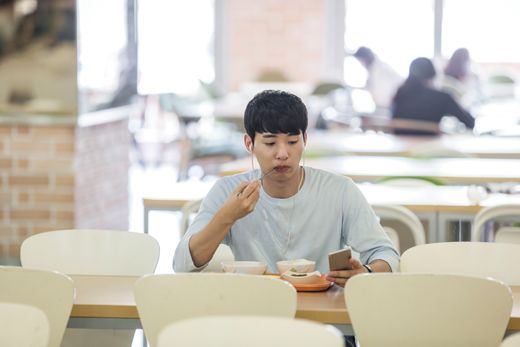
More Koreans are solo dining (Melissa, 2019)
More Koreans are solo dining (Melissa, 2019)

"One Nation divided under the Chaebol" (Hockmuth, 2016)
"One Nation divided under the Chaebol" (Hockmuth, 2016)

Korean Students facing mental exhaustion from school (Smudger81299, 2013)
Korean Students facing mental exhaustion from school (Smudger81299, 2013)

Many Koreans will order food at PC bangs or internet cafes while playing videogames. (Naeri, 2020)
Many Koreans will order food at PC bangs or internet cafes while playing videogames. (Naeri, 2020)
"Korea is a society of spectacle [] They have a different understanding of how media is used. It's become truly a part of life"
While essentially viewers are watching another person enjoy his/her meal, Mukbangs have greater socio-cultural implications. The rise in the popularity of Mukbangs coincides with the rapid technological advancements occurring in society, and the shift in entertainment focus on streamable content. Additionally, the popularity of mukbangs may be deeply rooted in more unpleasant psychology.
It has only been about 50 years since Korea has emerged as a leading nation. South Korea's economy boosted tremendously following WWII thanks to partnerships between the South Korean government and top “chaebol” or family-run companies like Samsung, LG, and Hyundai. These chaebol conglomerates helped organize and fund economic reformation plans throughout the country in return for tax cuts and government loans. Hyundai, for instance, was mainly responsible for South Korea’s first highway in the late 1960s that went from Seoul to Busan (Choi, 2017). The Korean government's symbiotic relationship with chaebol corporations allowed the country to emerge as a world leader seemingly overnight. Originally, South Koreans worried that the rapid globalization would be detrimental to traditional Korean culture as western ideas of individualism would replace collectivist ideas of sociality like “cheong”—Korean for duty and affection towards one’s peers and family. Kyungwon Yoon, PhD student at the University of Birmingham disputes the speculation and explains how traditional norms can instead be reinvented through globalized technology like the mobile phone. He suggests “Young Koreans try to maintain local sociality, embodied in Cheong space, by appropriating the mobile in certain ways; for example, the practices of immobiling and sharing. Using this example, I have addressed the argument that, in certain local contexts, globalization can be reworked via local sociality, which is deeply influencing and even retraditionalizing the global” (Yoon 2003, 340). Yoon proposes that communication and sharing via the mobile phone has helped extend one’s cheong to a wider network that is no longer limited to physical spaces like the home but also includes virtual spaces as well. Thanks to rapid technological advancements, Koreans are finding more ways to expand their cheong network to incorporate more diverse but commonly interested communities. Likewise, Mukbangs are the perfect example of what happens when universal technological adoption meets the constant need for connectivity. Michael Hurt, the director of cultural studies at South Korea’s Busan University of Foreign Studies, encapsulates the relation and states, “Korea is a society of spectacle, and it’s gotten to the point where social interaction can’t happen—can barely be understood—without being mediated in some way. They have a different understanding of how media is used. It's become truly a part of life" (Hong, 2016). In this way, Koreans have seamlessly incorporated technology and media to not only stay connected and broadcast their lives, but to also build relationships that are not necessarily reliant on in-person interaction.
The South Korean government has openly embraced symbiotic relationships between government and business in order to provide its citizens with the most up to date technology. In 2003, the South Korean Information and Telecommunication Ministry jointly infused $2.1 billion into the nation’s multimedia network with the nation's leading carriers (Choi 2017). Since then, Seoul, the capital of South Korea, has become “the bandwidth capital of the world” due to the widespread accessibility to 17 Mbps average data speeds, considered to be one of the highest in the industry (Hakimey and Yazdanifard 2015, 451). The fast speed internet allows the Korean people to easily communicate with Mukbang broadcasts at real-time speeds and the live streamed videos allow for a shared and interactive experience between the mukbanger and audience. As a result, people are able to make lasting connections with Mukbangers and fellow viewers.
In addition to rapid technological advancements, people may turn to Mukbangs as an escape from Korea’s unrealistic expectations and work-oriented life so as to cope with less connectivity and downtime. According to the World Health Organization, South Korea has the 10th highest suicide rate in the world with depression and suicide believed to stem from the culture's obsession with status (“Suicide Rate by Country 2020”). In the case of adolescents, it is commonplace for Korean students to spend strenuous hours at school and after-school prep programs to meet parents’ and societal standards of high academic achievement. MyCrazyKimchi, a foreigner teaching english in Korea, explains that high school students go to school or prep programs for 16 hours a day; “The average high school student generally has class from about 8am until 9:30pm or 10pm” (“10 Shocking Facts about Korean Schools”). In addition to ceaseless studying, the Korean school system also encourages competition by publicizing exam results and rankings. The competition encourages people to believe that another students’ success is theirs and everyone else’s loss. Addressing the constant competitive environment surrounding South Korean students, Kenneth G. Rice states, “Thus, they find themselves persistently experiencing criticism or being evaluated by others during school, at home, and in after-school programs. These pressures do not dissipate after entering college, as Korean students continue to perceive their academic performance as a main aspect of their identity” (Rice 2019, 387). The stress does not cease after people complete their education as Korean’s then compete for jobs and are expected to work unpaid overtime during the start of their career. Hence, Koreans are unable to escape the toxic perfectionist culture in which one’s identity is linked to their societal achievements. Pressure is not limited to students, but also young professionals who may be unable to find respected occupations, or elderly that may have to financially rely on their children. In an effort to cope with the enormous mental weight and sense of isolation, many Koreans have turned to mukbangs to heal and belong to a broader community in which they can escape and come as they are to enjoy food together with no questions asked.
Mukbang:
The Community

When looking more in-depth to the psychology behind Mukbang viewers, it can be argued that the emotional connection developed towards mukbangers and the sense of community are significant reasons as to why people watch the broadcast. Food brings people together in a way few other activities can and rooted in the foundations of Korean cooking is the belief that food has healing properties, especially if they are made by hand. Although it is a dying tradition, women of the community would come together each season to make kimchi, a popular Korean side dish, by marinating and fermenting the cabbage. Koreans believe this practice adds to the flavor of the food in which they can taste the love or “sone-mmahte,” directly translated as hand taste, in the kimchi. It portrays an old Malawian proverb, that "those who are one regarding food are at one with life."
Choi Ji-hwan, better known as Chef King Boryong takes it one step further and demonstrates how a mukbanger can bring together viewers of mutual experience to heal with food. “The 24-year-old mukbanger, who has thousands of Koreans tune in every night at 10 pm to watch him eat, provides cooking lessons as he cooks his meal dressed in army training outfits” (Hakimey and Yazdanifard 2015, 448). His kitchen, which he uses as his backdrop, is decorated with toy semi-automatic rifles as his fans relate with him their own army experience. Viewers experience a sense of nostalgia as they are taken back to their memories in the army during the live broadcast. Many male viewers will relate to the feeling because all South Korean men are required to serve in the military for two years. The chat screen further influences the sense of community among the audience by facilitating engagement between the viewers and mukbanger through comments, likes and donations. Even though the watchers may not know each other, the presence of other viewers is felt through conversations on the chat screen. Bruno and Chung (2017) similarly share that "The live chat before and after the meal could sometimes be more important than eating itself for some viewers. Content analysis disclosed that roughly 10% of viewers continued to tune in after the meal was finished to chat about different topics related to their lives" (Bruno and Chung, 2017). These chat interactions help develop relationships between the viewers themselves and also the mukbanger as the host will respond to viewers’ comments and thank the viewers who send virtual gifts. Anonymity also allows the audience to come as they are while being brought together under a common interest. In a study about digital commensality (the practice of eating together online), Spence argues how mukbangs can be used to psychologically promote commensality so that people may cope with solo dining (Spence, 2019). It conveys how mukbangs may provide interchangeable benefits to a person’s mental health that are similar to physically dining alongside others. Accordingly, Mukbangs provide a sense of community for those physically eating alone.
Video from Wallstreet Journal featuring Chef King Boryong (WSJ, 2014)
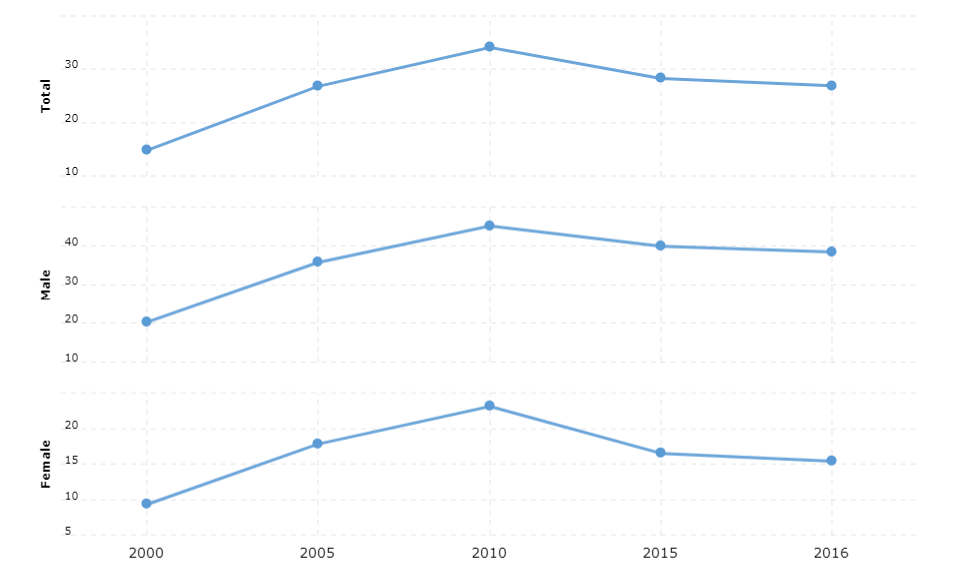
Korean Suicide Rate between 2000-2016 based on the suicide mortality rate (number of suicide deaths in a year per 100,000 population). ("South Korean Suicide Rate 2000-2020")
Korean Suicide Rate between 2000-2016 based on the suicide mortality rate (number of suicide deaths in a year per 100,000 population). ("South Korean Suicide Rate 2000-2020")
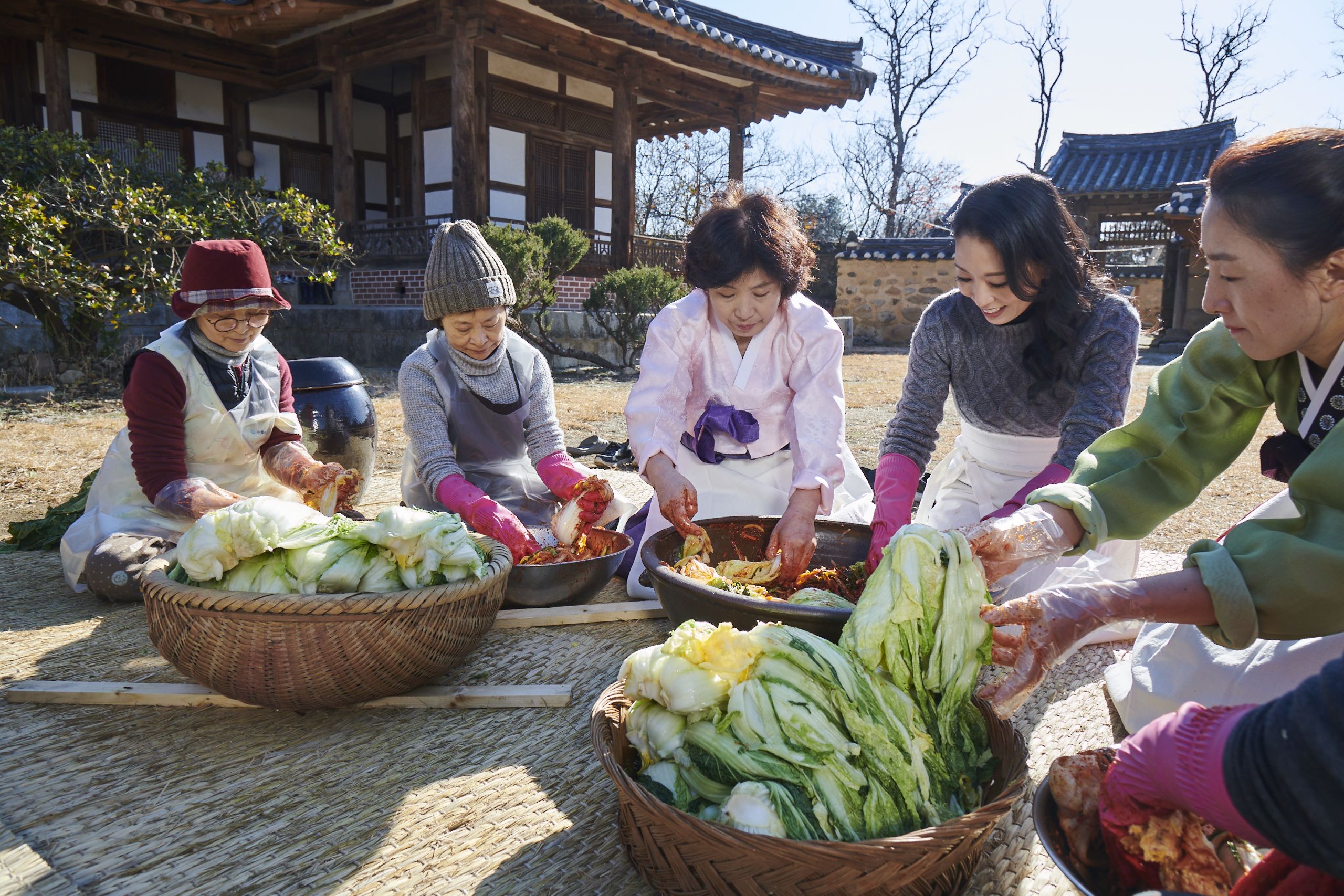
A community of Korean women coming together to make kimchi (Joo, 2019)
A community of Korean women coming together to make kimchi (Joo, 2019)

Korean Military seeing a marching song at basic training (Yonhap, 2020)
Korean Military seeing a marching song at basic training (Yonhap, 2020)
Mukbang:
The Socio Cultural

Mukbangs can also help to broaden our experiences for those who have dietary restrictions or allergens. Someone who may be deathly allergic to shrimp and is curious about how it tastes can watch a shrimp mukbang to reimagine that experience. Although it is not the same as personally deboning the shrimp and taking a bite of the meat yourself, watching and listening to those visual and audio elements in a mukbang video may help the viewer be a part of that meal that they otherwise could not physically share. In such a way, mukbangs also act in resistance to the impractical beauty standards of society. Astrid Schwegler-Castañer addresses the cultural implications of mukbangs in supporting the feminist rhetoric; she states, “In a culture imbued with the cult of thinness, where public shame is used to police people’s behaviours [], the birth of muk-bang as a stylized performance of culinary overconsumption can be attributed to its subversion of feminine bodily restraint and constant body monitoring” (Schwegler-Castañer, 783). While society’s expectations push us to always keep our figure, a Mukbanger’s response is to eat senselessly. Female viewers may be drawn to mukbangs as a way of silently protesting gender expectations as they feel connected to females that eat messily, are loud, and eat too much even though they may see these behaviors as transgressive acts in themselves. It provides viewers satisfaction via the sensation of binge eating without having to do so through “magical eating fantasy; the idea of eating as much as desired without suffering the consequences” (Gillespie, 2019). Mukbangs serve as a way to escape from stress. Whether it is because you are running from a sense of guilt from being overweight or whether it is to escape physical hunger for children who are unable to order food when their parents are out, whatever the case, people enjoy mukbang as an escape from unpleasant reality. Thus, Mukbangs embody our fantasies as we live vicariously through the broadcaster.
Mukbangs also bring viewers a sense of human comfort that can be physically felt through an autonomous sensory meridian response (ASMR). Mukbang listeners may feel what can be called a “braingasm,” which viewers describe as a tingling sensation down one’s spine which triggers a sense of relaxation and comfort. The chopping sounds of cooking or the crunching sounds from biting are what is said to relax the listeners. As it becomes more challenging to dine with others in our increasingly individualistic lifestyles, watching Mukbangs can ameliorate the feeling of alienation through the presence of what Steve Connor calls the vocalic body, so while we are physically dining alone, the presence of another is authentically felt. According to Connor, “[the principle of the vocalic body is simple. Voices are produced by bodies: but can also themselves produce bodies. The vocalic body is the idea—which can take the form of a dream, fantasy, ideal, theological doctrine, or hallucination—of a surrogate or secondary body, a projection of a new way of having or being a body, formed and sustained out of the autonomous operations of the voice” (Connor 2008, 35). Mukbangs invite listeners to enjoy their meals, a regular and repeated daily experience, while also enjoying the sensory feeling that sound evokes. The voice in these broadcasts comes to life as a body sitting next to us, eating alongside us, and talking with us. To hear then also becomes to touch as these senses become conjoined to the avid listener. Jocelyn Anderson depicts the experience and shares “They [mukbang viewers] rely on the affective power of the whispered voice’s [and chewing noises’] impression to create an intimate sonic space shared by the listener and the whisperer” (Anderson 2015, 684). Mukbang broadcasts are an immersively felt and intimate experience as vibrations from the sounds of cooking, eating, and conversing fill an empty room. Mukbang viewers experience a sensation of touch as the sounds of food that many associate with tingling, pleasant sensations provide viewers with a human sense of comfort and reassurance through telepresence. When the host visually and audibly enjoys his/her meal, the viewers can feel the presence of a body, which accounts for the chills down one’s spine characteristic of ASMR videos. As this phenomenon demonstrates, sound can lessen feelings of loneliness by bringing the audience a sense of human comfort that is in fact physically felt.
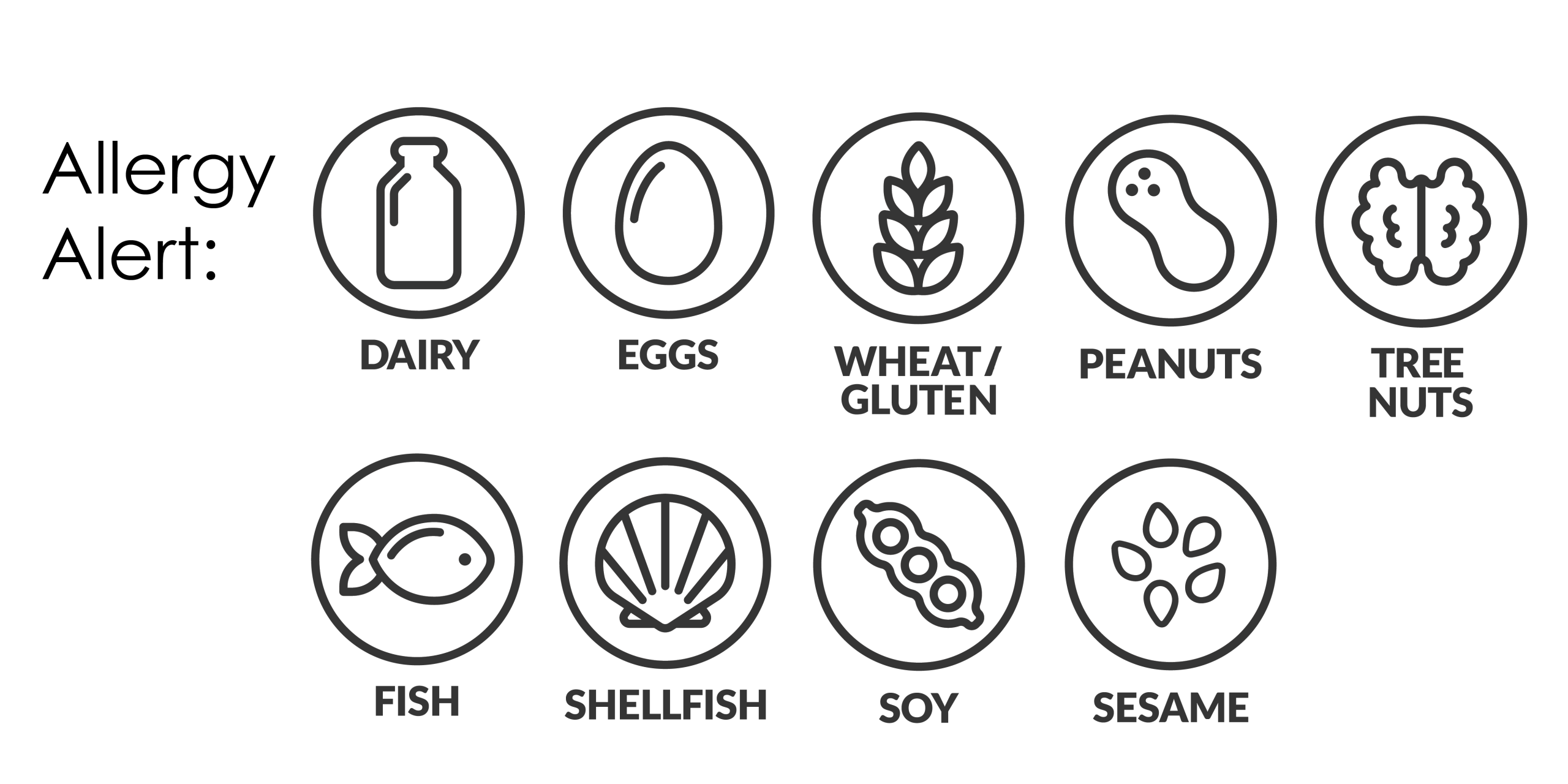
Mukbangs recreate experiences for people with dietary restrictions (Penn State, 2020)
Mukbangs recreate experiences for people with dietary restrictions (Penn State, 2020)

Mukbangs may help improve our relation to food and our body ("Understanding the difference...")
Mukbangs may help improve our relation to food and our body ("Understanding the difference...")
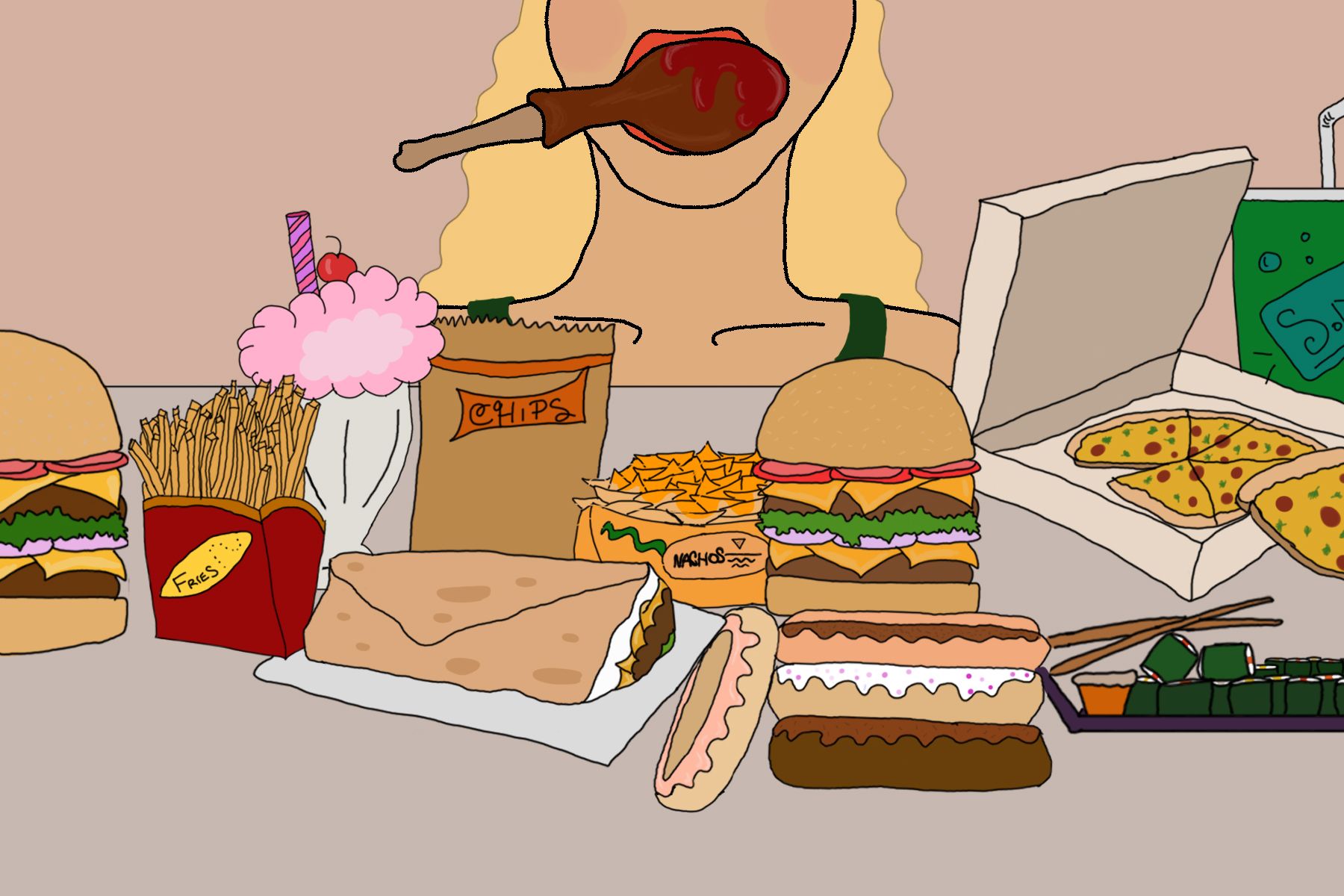
ASMR (Autonomous Sensory Meridian Response): listeners experience a braingasm described as a tingling sensation down one's spine (Zhu, 2020)
ASMR (Autonomous Sensory Meridian Response): listeners experience a braingasm described as a tingling sensation down one's spine (Zhu, 2020)

Vibrations in water depict how sound is a felt experience (Torrents, 2015)
Vibrations in water depict how sound is a felt experience (Torrents, 2015)
Mukbangs also offers a new format instead of the traditional cooking show by implementing ASMR and a stripped-back environment. Rather than exaggerating cooking through charismatic hosts, dramatic reactions, and cheesy music, Mukbangs emphasize the natural sounds of cooking. It no longer is about the final dish but allows the viewers to delight in the process of cooking by capturing the essence of cooking through a natural and peaceful auditory experience. On cooking shows we find on cable TV, something is constantly happening in an effort to keep the viewers' attention. It seems as though the host is always walking the viewer through each step until we reach the final dish. It feels like an advertisement in the form of a cooking show. When it comes to Mukbangs, people watching the videos get to enjoy the relaxing sounds of cooking, and the focus is not on copying the recipe: Sedacca states, “with ASMR it becomes more about the sound than the taste.” The alternative style introduces cooking to a broader audience instead of marketing solely towards stay-at-home moms. It strips all the unnecessary elements away, so viewers can enjoy a more pure and authentic experience. Mukbang cooking videos portray cooking as a minimalist everyday experience rather than as a luxurious commodity. It teaches us that it is no longer about becoming the chef, but rather being mindful of the cooking being done; the natural audio brings intimacy to the viewer and the artform of preparing food. With Mukbangs, it is as if your mom was cooking in the kitchen.
Video from Honeykiki where she prepares dolsot bibimbap (HoneyKiki, 2020)
Lastly and no less important, Mukbangs can also promote cultural awareness and diversity, as viewers are encouraged to try different foods that the host enjoys. When introduced to foreign food by a trusted and loved person, it encourages people to try the food themselves. Watching a mukbang host enjoy their country’s food may be the push someone needs to try different foods and become familiar with another culture. A real-life example of this would be when Hwasa, a kpop idol from the group Mamamoo, single-handedly sold out gopchang or cattle intestines throughout Seoul when a video of her eating it went viral. A day after the video surfaced, Korean BBQ restaurants were packed with people ordering the dish until it could no longer be found anywhere in the capital.
Video from Kocowa TV from the broadcast Home Alone (Kocowa, 2018)
As for me, you can find me watching mukbangs whenever I feel homesick. Sadly, where I go to school there are limited food and takeout options available and there is only so much dining hall food and ramen a student can take before he misses a warm home-cooked meal. That is when I turn on a Mukbang to be welcomed back to the comfort of home.
There are many socio-cultural and psychological reasons as to why people enjoy Mukbangs. Some people watch them to be connected to a community or to cope with feelings of alienation, while others will watch them as a way to imagine new experiences or as a way to lose weight. Whatever the case, Mukbangs are challenging social expectations. While it may be ill-mannered to slurp your soup in public, the popularity of Mukbangs proves that there are people that enjoy that exact sound. For people that are on diets, Mukbangs provide the fantasy of watching someone “eat their feelings” without having to physically overindulge themselves. Mukbangs demonstrate how listening can be an immersively tactile sensation through ASMR. It encourages viewers to appreciate and be mindful of food, cooking and eating as an art form. Lastly, Mukbangs are bringing the world to your plate by showcasing different meals and dishes enjoyed in diverse cultures and people. As Mukbangs continue to grow in popularity, they are questioning our preconceived ideas on how, what, and with whom we should enjoy our food.

Ghibli animated foods (Giphy, 2020)
Ghibli animated foods (Giphy, 2020)

(Giphy, 2020)
(Giphy, 2020)
